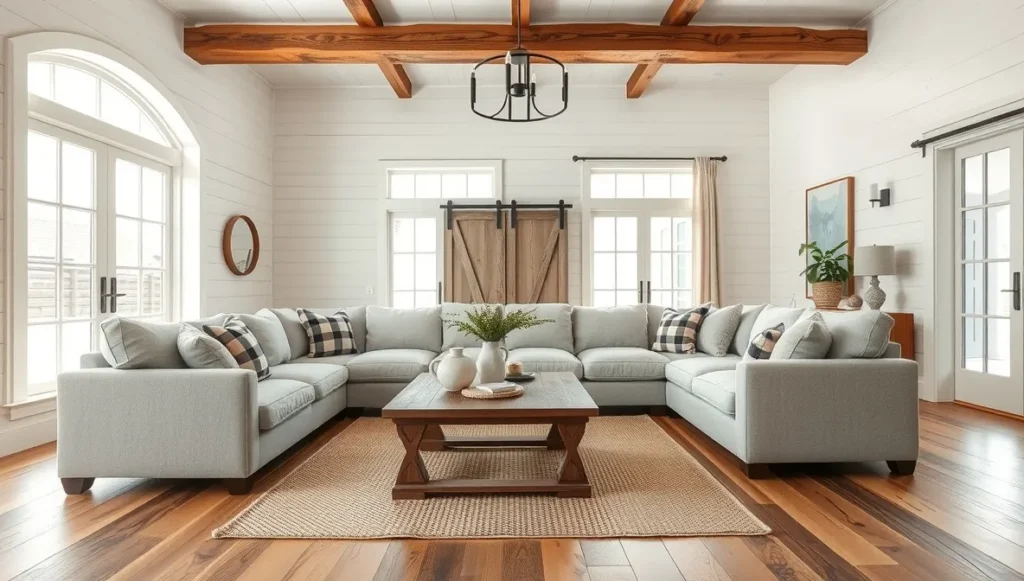- Why Vintage Interior Design Still Has My Heart - September 3, 2025
- Still in Love with Traditional Design – And Here’s Why - September 3, 2025
- The Enduring Charm of English Country Design: Why This Style Never Goes Out of Fashion - September 2, 2025
Table of Contents
Okay, confession time. Back in 2018 when everyone started going crazy for shiplap and barn doors, I thought it was just another flash-in-the-pan thing. You know how design trends work – one day everyone wants industrial lofts, next minute it’s all about Scandinavian minimalism.
But here’s the weird part. Seven years later, I’m still doing farmhouse projects almost every week. My phone won’t stop ringing with people wanting “that cozy but clean look.” So either I’m completely wrong about trends (possible) or there’s something bigger happening here.
Turns out, people aren’t just copying what they see on HGTV. They’re responding to something farmhouse design does really well – it makes homes feel like, well, homes.
What’s This Whole Modern Farmhouse Thing About Anyway?
Traditional farmhouse style had some issues. Too much stuff everywhere, overly cutesy decorations, and honestly? Not great for people who don’t want their living room looking like a craft store exploded.
Modern farmhouse fixed those problems. Keep the cozy warmth, ditch the rooster collections. Use real materials instead of plastic everything. Make spaces that work for actual families instead of just looking pretty in photos.
The basics are pretty straightforward:
- Real materials beat fake ones every single time
- Everything should have a job to do, not just sit there looking decorative
- Comfortable doesn’t mean sloppy, and stylish doesn’t mean uncomfortable
Simple concept. Execution? That’s where things get interesting.
Color Choices That Won’t Make You Regret Everything in Two Years
I’ve watched too many clients fall in love with trendy colors that made them miserable six months later. Farmhouse colors work because they’re basically stolen from nature, and nature doesn’t really go out of style.
Start with whites. Not that hospital white that makes everyone look dead, but warmer versions. Cloud White and Alabaster are my go-to picks because they have enough warmth to feel welcoming but still photograph beautifully for your Instagram stories.
For other colors, literally look outside your windows. What colors does nature mix together in your area? Those work in your house too. Forest greens never look dated. Navy blues feel classic without being boring. Charcoal grays add sophistication without going too dark.
Pro tip from someone who’s made this mistake: don’t pick colors from those tiny paint chips under store lighting. Buy samples, paint huge swatches on your walls, live with them for at least a week. Colors change completely depending on your lighting and what time of day you’re looking at them.
Where to Spend Money (And Where You Can Skip)
Fifteen years of watching people blow their budgets has made me pretty opinionated about this stuff.
Wood is everything. Seriously. Real hardwood floors, actual wood cabinets, genuine reclaimed beams – this is your foundation. Fake wood fools nobody and ages terribly. If money’s tight, use real wood strategically instead of covering every surface with laminate.
Cabinet hardware matters more than you think. Those little pulls and knobs get touched dozens of times per day. Cheap hardware feels cheap every single time. Good hardware makes basic cabinets look custom. Stick with black iron, brass, or bronze and use the same finish throughout your house.
Natural stone develops character. Marble, granite, even simple limestone – they all get better with age. The fake stuff often looks great when new but shows its true colors after a few years of real use. Quartz gives you natural stone appearance with better stain resistance if you’re worried about maintenance.
Room by Room Reality Check
Kitchens for People Who Actually Cook
Shaker-style cabinets are popular for good reasons – clean lines without too much fuss, they work with farmhouse or more contemporary looks, and they don’t scream “2020s design trend” like some other styles might.
That farmhouse sink everyone wants? Get one, but pick composite materials over cast iron unless you enjoy scrubbing stains. An apron front looks classic and handles big pots better than regular undermount sinks.
Open shelving photographs beautifully but be realistic about maintenance. Most families need closed cabinets for hiding the random collection of takeout containers and mismatched storage bowls that accumulate over time.
Kitchen islands need to actually work. Make them big enough to be useful, include seating that fits real human bodies (test this – seriously), and plan electrical for all the gadgets modern families actually use.
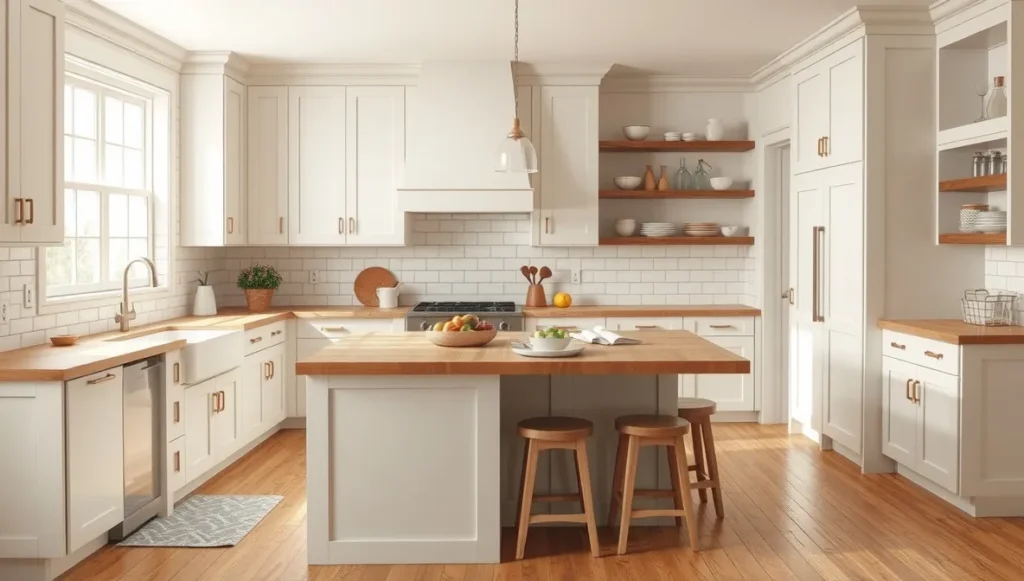
Living Rooms Where Families Hang Out
Forget those picture-perfect white sofas you see in magazines. Real families deal with movie nights, pets, kids with juice boxes, and the occasional wine disaster. Choose upholstery colors that hide life’s little accidents – grays, taupes, navy blues.
One substantial vintage piece beats a bunch of small decorative items. Find that perfect farmhouse table, old church pew, or weathered cabinet and build your room around it. Everything else should support your star player, not fight for attention.
Window treatments can make or break the look. Heavy formal drapes feel wrong, but bare windows miss opportunities for softness. Simple linen panels or roman shades hit the sweet spot.
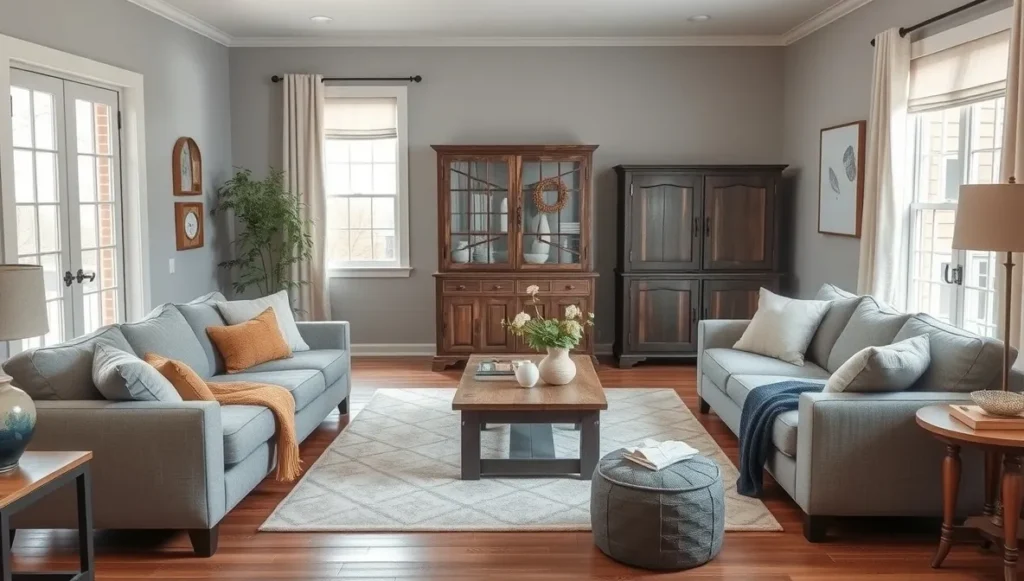
Dining Areas That Work Every Day
Size your dining table for regular use, not just holiday gatherings. A table that comfortably seats six beats one that technically fits eight but leaves everyone playing elbow hockey during dinner.
Mixing bench seating with regular chairs gives you flexibility and kids actually prefer benches anyway. Plus benches tuck completely under tables when you need floor space for other activities.
Lighting gets overlooked but it’s crucial. Too dim and meals feel depressing. Too bright and you’re eating under interrogation conditions. Get dimmable fixtures or chandeliers with multiple bulb options.
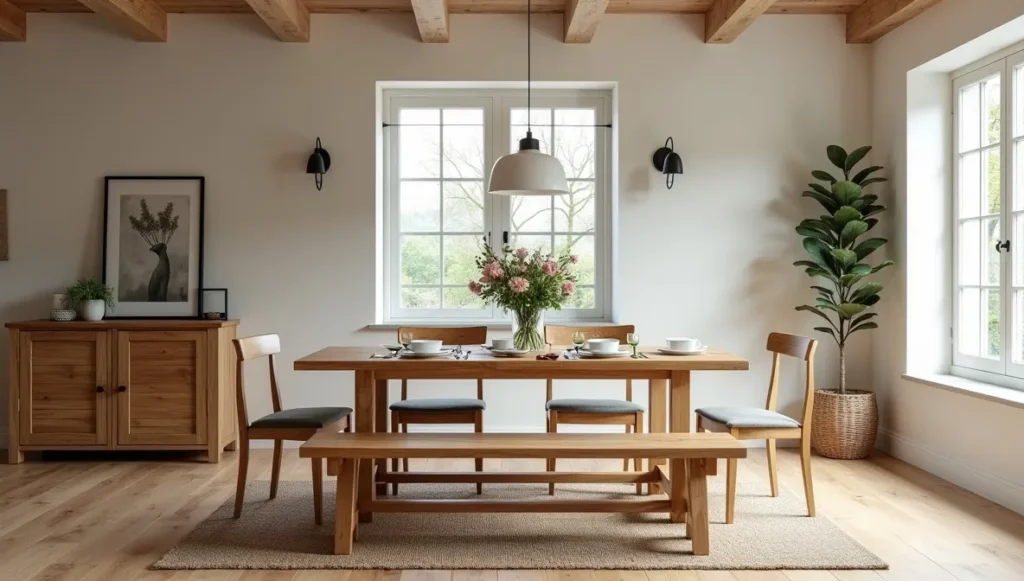
Bedrooms That Feel Like Actual Retreats
Keep bedroom design simple. Platform beds in real wood, bedding in whites or creams with texture from throws and different pillow fabrics, window treatments that actually block light when you need sleep.
Built-in storage works beautifully here. Window seats with hidden storage underneath, custom wardrobes painted to match walls, or even simple floating shelves for books and personal items.
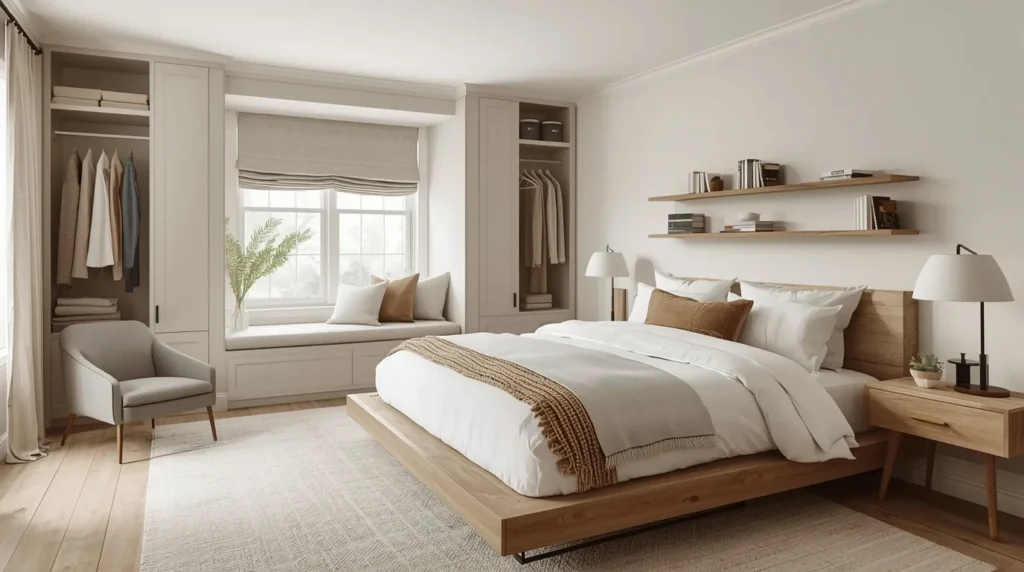
Kids’ bedrooms benefit from farmhouse durability. Choose furniture that adapts as they grow – convertible cribs, dressers that work as changing tables then regular storage, neutral wall colors that survive changing interests from dinosaurs to pop stars.
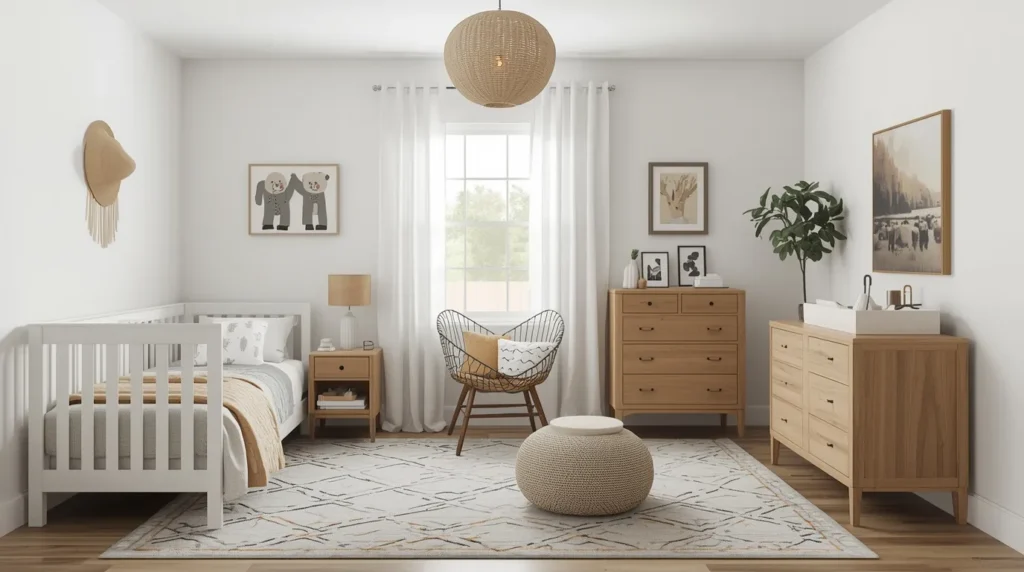
Bathrooms That Don’t Become Maintenance Nightmares
Subway tile isn’t mandatory but it works because it’s timeless and easy to keep clean. Handmade versions add character without creating cleaning headaches.
Vanities present big opportunities. Repurposed vintage furniture looks incredible but check with your plumber first – some antique pieces create expensive installation problems. Purpose-built vanities with farmhouse styling often work better practically.
Freestanding tubs are gorgeous when space allows. If not, invest in a really good walk-in shower with quality fixtures rather than cramming in a tub nobody will use.
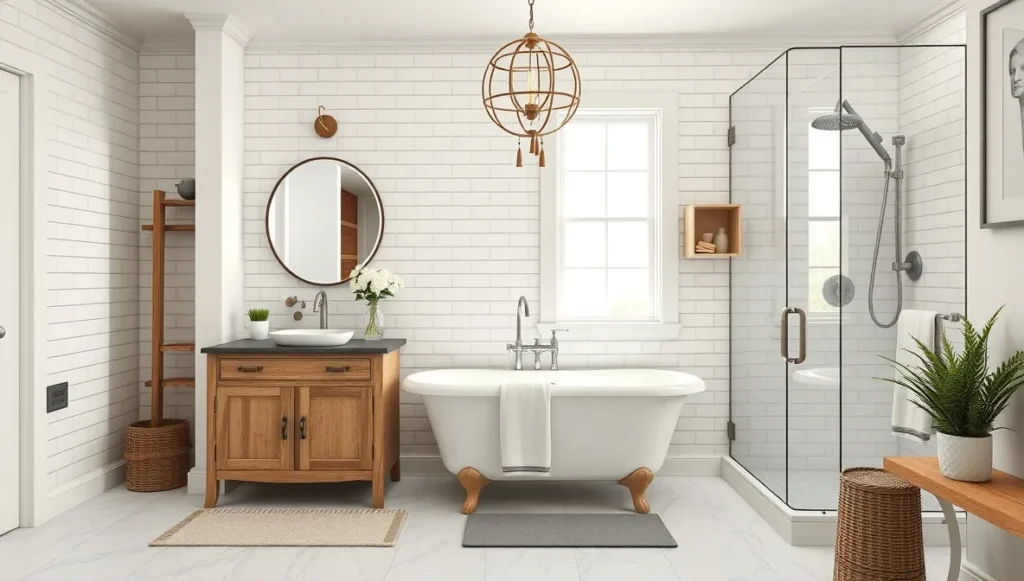
Expensive Mistakes I See Constantly
Everything distressed and weathered. If every piece looks aged and beaten up, nothing feels special. Choose your distressed elements carefully and balance them with cleaner pieces.
Tiny lighting fixtures. Small lights disappear in farmhouse-scale rooms. When you’re debating fixture sizes, go bigger than your first instinct.
No storage planning. Beautiful rooms that can’t handle daily life don’t work long-term. Figure out where your stuff lives before you worry about how pretty everything looks.
Shopping sprees. The best farmhouse spaces feel collected over years, not purchased in one weekend. Start with major pieces and add character gradually.
Adapting This Style to Real Life
Most people don’t live in sprawling country houses, which is totally fine. Modern farmhouse principles work in apartments, urban townhouses, suburban splits – pretty much anywhere.
In smaller spaces, focus on what you can change without major renovation. Swap out basic builder hardware, add reclaimed wood accents where possible, choose lighting with farmhouse character, incorporate natural textiles through rugs and pillows.
Contemporary homes actually benefit from farmhouse softening. Keep those clean modern lines but warm them up with natural materials and casual comfort elements.
Why This Style Actually Sticks Around
After doing this work for fifteen years, I think I’ve figured out the real appeal. Modern farmhouse isn’t about following design rules or recreating Pinterest boards. It’s about making homes feel genuine when so much else in life feels artificial.
People want spaces that look put-together but don’t require perfect maintenance. They want rooms that work for their messy, busy, real lives while still being pleasant when friends come over. They want permission to mix expensive pieces with flea market finds, new purchases with family heirlooms.
Modern farmhouse gives them that permission. Done right, it creates homes that feel welcoming instead of intimidating, comfortable instead of precious, authentic instead of trying too hard.
And honestly? In a world where everything feels increasingly fake and digital, that authenticity becomes more valuable every year.
